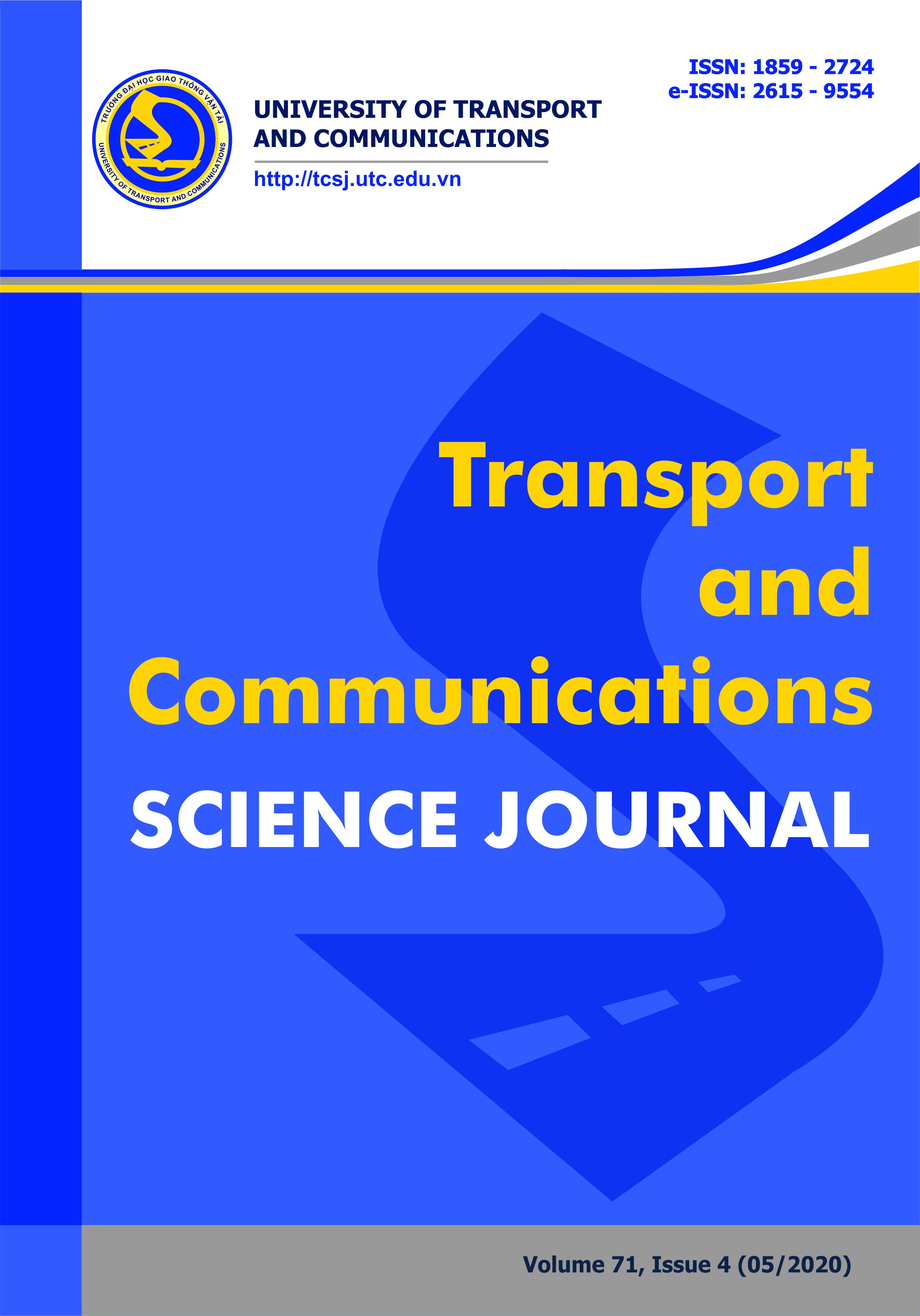Geometric non-linearity in a multi-fiber displacement-based finite element beam model – an enhanced local formulation under torsion
Email:
tuan-anh.nguyen2@insa-rennes.fr
Từ khóa:
Geometrically nonlinear beams, large deformation, reinforced concrete, multi-fiber beam, corotational formulation, torsional effect reinforced concrete.
Tóm tắt
This paper deals with a geometrically nonlinear finite element formulation for the analysis of torsional behaviour of RC members. Using the corotational framework, the formulation is developed for the inclusion of nonlinear geometry effects in a multi-fiber finite element beam model. The assumption of small strains but large displacements and rotations is adopted. The principle is an element-independent algorithm, where the element formulation is computed in a local reference frame which is uncoupled from the rigid body motions (translations and rotations) of the reference frame. In the corotational based frame, strains and stresses are measured from corotated to current, while base configuration is maintained as reference to measure rigid body motions. Corresponding to the requirement of corotational based, in the local frame, taking into account the torsional effect conducts to nonlinear strain assumption, thus require some specific development using a new kinematic model. Second order strain is accounted in the axial term, however lateral buckling is neglected, therefore this formulation is recommended to use in case of solid cross-section with arbitrarily large finite motions, but small strains and elastic material behaviour, such as slender of long-span reinforced concrete beam-column under flexion-torsional effect following serviceability limit state design. The enhanced formulation is validated in linear and nonlinear material range by several examples concerning beams of rectangular cross-section.Tài liệu tham khảo
[1]. J. M. Battini, C. Pacoste, Co-rotational beam elements with warping effects in instability problems, Comput. Methods. Appl. Mech. Engrg, 191 (2002) 1755-1789. https://doi.org/10.1016/S0045-7825(01)00352-8
[2]. C. C. Rankin, F. A. Brogan, An element independent co-rotational procedure for the treatment of large rotations, ASME J. Pressure Vessel Technol., 108 (1986) 165-174. https://doi.org/10.1115/1.32647655
[3]. C. A. Felippa, B. Haugen, A unified formulation of small-strain corotational finite element: I. Theory, Comput. Methods. Appl. Mech. Engrg, 194 (2005) 2285-2335. https://doi.org/10.1016/j.cma.2004.07.035
[4]. R. Alsafadie, M. Hjiaj, J. M. Battini, Three dimensional formulation of a mixed corotational thin-walled beam element incorporating shear and warping deformation, Thin-walled Structures, 49 (2011) 523-533. https://doi.org/10.1016/j.tws.2010.12.002
[5]. S. de Miranda, A. Madeo, D. Melchionda, L. Patruno, A. W. Ruggerini, A corotational based geometrically nonlinear Generalized Beam Theory: buckling FE analysis, Int. J. of Solids and Structures, 121 (2017) 212-227. https://doi.org/10.1016/j.ijsolstr.2017.05.030
[6]. C. C. Huang, S. C. Peng, W. Y. Lin, F. Fujii, K. M. Hsiao, A buckling and postbuckling analysis of axially loaded thin-walled beams with point-symmetric open section using corotational finite element formulation, Thin-Walled Structures, 124 (2018) 558-573. https://doi.org/10.1016/j.tws.2017.11.056
[7]. Phu-Cuong Nguyen, Seung-Eock Kim, A new improved fiber plastic hinge method accounting for lateral-torsional buckling of 3D steel frames, Thin-Walled Structures, 127 (2018) 666-675. https://doi.org/10.1016/j.tws.2017.12.031
[8]. T-A. Nguyen, Q-H. Nguyen, H. Somja, An enhanced finite element model for reinforced concrete members under torsion with consistent material parameters, Finite Element in Analysis and Design, 167 (2019) 103323. https://doi.org/10.1016/j.finel.2019.103323
[9]. R. Gruttmann, R. Sauer, W. Wagner, Theory and numerics of three-dimensional beams with elastoplastic behaviour, Int. J. Numer. Methods. Engrg, 48 (2000) 1675-1702. https://doi.org/10.1002/1097-0207(20000830)48:12<1675::AID-NME957>3.0.CO;2-6
[10]. J. Friedman, Z. Kosmatka, An improved two-node Timoshenko beam finite element, Computeurs and Structures, 47 (1993) 473-481. https://doi.org/10.1016/0045-7949(93)90243-7
[11]. V. Z. Vlasov, Thin Walled Elastic Beams, Fizmatgiz, Moscow, 1959.
[12]. T. T. C. Hsu, Torsion of reinforced concrete, Van Nostrand Reinhold, New York, 1984.
[2]. C. C. Rankin, F. A. Brogan, An element independent co-rotational procedure for the treatment of large rotations, ASME J. Pressure Vessel Technol., 108 (1986) 165-174. https://doi.org/10.1115/1.32647655
[3]. C. A. Felippa, B. Haugen, A unified formulation of small-strain corotational finite element: I. Theory, Comput. Methods. Appl. Mech. Engrg, 194 (2005) 2285-2335. https://doi.org/10.1016/j.cma.2004.07.035
[4]. R. Alsafadie, M. Hjiaj, J. M. Battini, Three dimensional formulation of a mixed corotational thin-walled beam element incorporating shear and warping deformation, Thin-walled Structures, 49 (2011) 523-533. https://doi.org/10.1016/j.tws.2010.12.002
[5]. S. de Miranda, A. Madeo, D. Melchionda, L. Patruno, A. W. Ruggerini, A corotational based geometrically nonlinear Generalized Beam Theory: buckling FE analysis, Int. J. of Solids and Structures, 121 (2017) 212-227. https://doi.org/10.1016/j.ijsolstr.2017.05.030
[6]. C. C. Huang, S. C. Peng, W. Y. Lin, F. Fujii, K. M. Hsiao, A buckling and postbuckling analysis of axially loaded thin-walled beams with point-symmetric open section using corotational finite element formulation, Thin-Walled Structures, 124 (2018) 558-573. https://doi.org/10.1016/j.tws.2017.11.056
[7]. Phu-Cuong Nguyen, Seung-Eock Kim, A new improved fiber plastic hinge method accounting for lateral-torsional buckling of 3D steel frames, Thin-Walled Structures, 127 (2018) 666-675. https://doi.org/10.1016/j.tws.2017.12.031
[8]. T-A. Nguyen, Q-H. Nguyen, H. Somja, An enhanced finite element model for reinforced concrete members under torsion with consistent material parameters, Finite Element in Analysis and Design, 167 (2019) 103323. https://doi.org/10.1016/j.finel.2019.103323
[9]. R. Gruttmann, R. Sauer, W. Wagner, Theory and numerics of three-dimensional beams with elastoplastic behaviour, Int. J. Numer. Methods. Engrg, 48 (2000) 1675-1702. https://doi.org/10.1002/1097-0207(20000830)48:12<1675::AID-NME957>3.0.CO;2-6
[10]. J. Friedman, Z. Kosmatka, An improved two-node Timoshenko beam finite element, Computeurs and Structures, 47 (1993) 473-481. https://doi.org/10.1016/0045-7949(93)90243-7
[11]. V. Z. Vlasov, Thin Walled Elastic Beams, Fizmatgiz, Moscow, 1959.
[12]. T. T. C. Hsu, Torsion of reinforced concrete, Van Nostrand Reinhold, New York, 1984.
Tải xuống
Chưa có dữ liệu thống kê

Nhận bài
13/04/2020
Nhận bài sửa
06/05/2020
Chấp nhận đăng
18/05/2020
Xuất bản
28/05/2020
Chuyên mục
Công trình khoa học
Kiểu trích dẫn
Tuan-Anh, N. (1590598800). Geometric non-linearity in a multi-fiber displacement-based finite element beam model – an enhanced local formulation under torsion. Tạp Chí Khoa Học Giao Thông Vận Tải, 71(4), 388-402. https://doi.org/10.25073/tcsj.71.4.8
Số lần xem tóm tắt
147
Số lần xem bài báo
152








